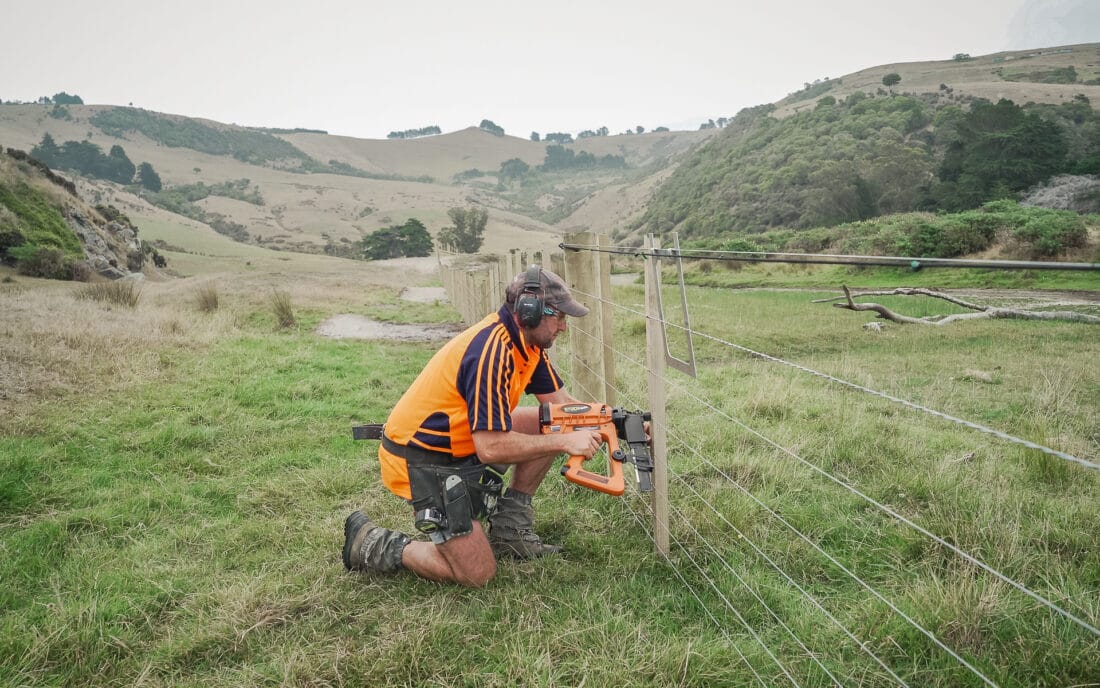Nick Terry from Custom Fencing, Waikouaiti, Otago
Tell us about the Halo Project?
For this particular job, we are working at Heyward Point, just out of Dunedin. It is one of many jobs between Heyward Point to North of Palmerston which are part of the Halo Project and feed into the vision of the Orokonui Eco Sanctuary.
How does the location impact the project?
The odd sea fog sits in these valleys and can stay for days. It is chock full of salt, so the less steel on steel we have the better. In this particular job, we have gone with 8 wire and batten for a longer-lasting fence.
Predominantly across Otago, we can have trouble getting posts in the ground, but this location has a sandy soil base which presents us with an almost ‘North Island problem’ where they can have trouble keeping posts in the ground.
What do you do to overcome the challenges of sandy soil?
All the termination strainers we are using are three-metre strainers. They are all sunk all the way down to combat any lift with a full-length post driven behind the stay.
Our posts are footed with waratahs and a six-inch nail which is fairly standard for our practice. Boat footing or swinging foots, which are often used up North don’t usually suit these conditions well.
The odd time, when we are in a really sandy spot or the post has a bit of uplift, we will use a deer post or a longer stay that will give more depth and a bit more hold.
How do you manage the time component of large projects?
Obviously, efficiency is a massive consideration. You don’t want to be walking down the fenceline empty-handed or have nothing to do. Being able to run a wire and staple it on the way back or drive posts and put insulators on at the same time, makes the job nice and quick.
We purchased the Stockade cordless ST315i batten stapler as soon as it became available because it stopped us from having to drag around a hose and the compressor. For this job we are using the ST400i stapler with the attachment for putting insulators, which also speeds up the job.
What do you need to think about when factoring in the time allocation of jobs like this?
Ground conditions is a massive part of how long a job may take in our area. This current job is all sand, but you only have to drive 100m up the hill and you start to find volcanic rock boulders. Another 600m up the road there can be a pan of volcanic rock which in past times we have had to blast to get posts into the ground.
Knowing the area you are fencing in plays a massive part in how long a job may take to complete or what the best materials to use are. Having been around the area fencing for 10 years, we have a good knowledge of what to expect when pricing or looking at a job. We have invested in good equipment. Compressors and rock drills, rock auger and spikes speed up the process when we do find hard ground. This allows us to complete the job to the same high standard and get it done as quickly as we can, managing our workload and lessening disturbance to the farmers.
Fence materials
- Posts 1.8m x 125mm round posts
- Strainer end assemblies 3m x 200mm strainers, 2.4 x 125mm stays
- Angles are 2.7m x 175mm strainers.
Machinery & Equipment
- Massey Fergusson tractors
- Revolution Post drivers
- ST400i
- ST315i
- Quad Jenny
- Can-Am side-by-side motorbike.

